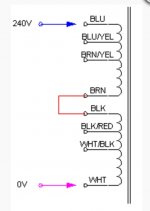You could get more power for sure if you bias colder and at higher B+, but you would sacrifice linearity.
I just don't know who makes a 250W+ 5k transformer.
Just trying to understand output Transformers a bit better so I am going to ask a really stupid question probably.
Can you use output transformers in Series?
Say you get 2 identical 125W 2.5k transformers and series joined them side by side.
Would that actually work?
Could you use the 2 joined leads like the CT of the transformer?
What would it do to the output/secondaries and their ratings?
Or does impedance work differently to resistance when joining wound components?
OK so I lied and its probably more than 1 stupid question 😕
So if you did that, you wouldn't have the DC from the two tubes cancelling the flux in the transformer core, since it wouldn't be going opposite directions in the same transformer. You could use a gapped core like an SE amp, but I think the two transformers will end up being huge.
However, there is a way to do this. Have a look at Norman Crowhurst's Twin Coupled amplifier design. That puts the windings from two transformers in series in a way that will have each one cancel flux. It also makes the output stage voltage drive requirements huge due to the cathode feedback, but it is also very linear.
If we want to turn the "daft" up to 11, we could do this with 813s. There are commercial output transformers that would do the job.
Drive requirements would be huge but I developed a driver some time ago that is up to the task. See this thread. I ended up getting ~325Vrms out at 0.6% distortion from an EL34. I'm sure I could squeeze a little more out of it.
However, there is a way to do this. Have a look at Norman Crowhurst's Twin Coupled amplifier design. That puts the windings from two transformers in series in a way that will have each one cancel flux. It also makes the output stage voltage drive requirements huge due to the cathode feedback, but it is also very linear.
If we want to turn the "daft" up to 11, we could do this with 813s. There are commercial output transformers that would do the job.
Drive requirements would be huge but I developed a driver some time ago that is up to the task. See this thread. I ended up getting ~325Vrms out at 0.6% distortion from an EL34. I'm sure I could squeeze a little more out of it.
Yes,it certainly makes winding transformers like these a challenge. Thanks also for the link re protection.Remember that the voltage on the plates of an output tube will reach 2 X the B+ voltage
Kobamax does something similar using two toroids stacked one on top of each other, primaries series connected, secondary's parallel connected. I thought of using the same wrinkle on this amp as big toroid cores are relatively easy and cheap to get.Can you use output transformers in Series?
I'm still plugging away at this amp and will keep you all updated if I make any progress.
Andy.
I think I just answered my own question.
I noticed when browsing the Hammond transformers that they are 117V and 240V depending on how you wire them. So they are essentially 2 primary coils in series but obviously the secondary is still 1 coil only.
But it states for 110V operations both primaries must be connected.
I mean they have done more than just slap 2 coils next to each other and would have been a lot of mathematics gone into it.
I noticed when browsing the Hammond transformers that they are 117V and 240V depending on how you wire them. So they are essentially 2 primary coils in series but obviously the secondary is still 1 coil only.
But it states for 110V operations both primaries must be connected.
I mean they have done more than just slap 2 coils next to each other and would have been a lot of mathematics gone into it.
Attachments
> for 110V operations both primaries must be connected.
The copper is there for a reason. To get ALL the power rating that you paid for, you have to use all the copper. If you use one winding of a 2-winding primary, you might only get half the expected power before something blows-up. Actually the limits on transformers tend to average-out and a single 110V winding *might* get near 3/4 full power without overheating. It may sag more than expected.
The copper is there for a reason. To get ALL the power rating that you paid for, you have to use all the copper. If you use one winding of a 2-winding primary, you might only get half the expected power before something blows-up. Actually the limits on transformers tend to average-out and a single 110V winding *might* get near 3/4 full power without overheating. It may sag more than expected.
Two primaries in series = twice the voltage, half the current, two primaries in parallel = half the voltage, twice the current. So for a 400VA tfmr 250v x 2A or 125 x 4A. That's why on some amps two values of fuse are given.
Andy.
Andy.
